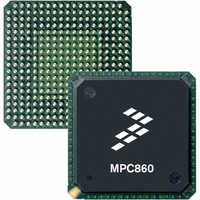MC68MH360ZP33L Freescale Semiconductor, MC68MH360ZP33L Datasheet - Page 758

MC68MH360ZP33L
Manufacturer Part Number
MC68MH360ZP33L
Description
IC MPU 32BIT QUICC 357-PBGA
Manufacturer
Freescale Semiconductor
Specifications of MC68MH360ZP33L
Processor Type
M683xx 32-Bit
Speed
33MHz
Voltage
5V
Mounting Type
Surface Mount
Package / Case
357-PBGA
Lead Free Status / RoHS Status
Contains lead / RoHS non-compliant
Features
-
Available stocks
Company
Part Number
Manufacturer
Quantity
Price
Company:
Part Number:
MC68MH360ZP33L
Manufacturer:
FREESCALE
Quantity:
1 831
Company:
Part Number:
MC68MH360ZP33L
Manufacturer:
MOTOLOLA
Quantity:
672
Company:
Part Number:
MC68MH360ZP33L
Manufacturer:
Freescale Semiconductor
Quantity:
10 000
Part Number:
MC68MH360ZP33L
Manufacturer:
FREESCALE
Quantity:
20 000
Company:
Part Number:
MC68MH360ZP33LR2
Manufacturer:
Freescale Semiconductor
Quantity:
10 000
- Current page: 758 of 962
- Download datasheet (5Mb)
Applications
dled differently. See 9.4.2 Memory Interfaces.) To provide dynamic bus sizing, the MC68150
device may be added to the design shown here.
Parity is supported for both SRAM and DRAM arrays using the four-byte parity lines
PRTY3–PRTY0. When a parity error occurs, the error indication on the PERR pin causes
the QUICC to generate a level 5 interrupt to the MC68EC040. (Level 7 has already been
used for the breakpoint generation interrupt.) The parity error timing is not fast enough to
allow an MC68EC040 bus error to be generated on the bus cycle that generated a parity
error.
The QUICC supports MC68EC040 bursting using the BADD3–BADD2 pins. These pins nor-
mally reflect the values on A3–A2, but, in the case of a burst, are used to increment the
address to the memory array. If the memory devices already support MC68EC040 bursting
internally, the BADD3–BADD2 pins are not required.
The DRAM arrays require the four CAS3–CAS0 pins. Also, since an external address mul-
tiplexer is used, the AMUX pin is required to select between rows and columns. If, however,
the user's configuration does not require DRAM, the AMUX pin can be used as an OE pin
instead. This would save an inverter in a number of memory arrays.
The QUICC also provides four write enable (WEx) pins to select the correct byte during write
operations.
9.4.2.2 REGULAR EPROM. Figure 9-9 shows the glueless interface to standard EPROM
in the system. The assumption is made that only the MC68EC040 will access this array. No
bursting capability is used. The CONFIG2–CONFIG0 pins are configured to initialize the
system to slave mode, CS0 operating on a 32-bit port at reset, the MBAR at its normal loca-
tion, and MC68040 companion mode.
It would have been possible to use 16-bit-wide EPROM to reduce the chip count, if desired.
(See 9.4.2.3 Burst EPROM. for an example.)
9.4.2.3 BURST EPROM. Figure 9-10 shows the glueless interface to two burst EPROMs
available from National Semiconductor. These devices support a glueless interface to the
MC68040. In this design, the assumption is made that only the MC68EC040 will access this
array.
9-38
Many memory arrays show an inverter on the R/W pin to create
the OE signal. When using multiple memory arrays, it is possible
to share one inverter between multiple memory arrays; however,
this configuration is not shown.
Freescale Semiconductor, Inc.
For More Information On This Product,
MC68360 USER’S MANUAL
Go to: www.freescale.com
NOTE
MOTOROLA
Related parts for MC68MH360ZP33L
Image
Part Number
Description
Manufacturer
Datasheet
Request
R
Part Number:
Description:
Manufacturer:
Freescale Semiconductor, Inc
Datasheet:
Part Number:
Description:
Manufacturer:
Freescale Semiconductor, Inc
Datasheet:
Part Number:
Description:
Manufacturer:
Freescale Semiconductor, Inc
Datasheet:
Part Number:
Description:
Manufacturer:
Freescale Semiconductor, Inc
Datasheet:
Part Number:
Description:
Manufacturer:
Freescale Semiconductor, Inc
Datasheet:
Part Number:
Description:
Manufacturer:
Freescale Semiconductor, Inc
Datasheet:
Part Number:
Description:
Manufacturer:
Freescale Semiconductor, Inc
Datasheet:
Part Number:
Description:
Manufacturer:
Freescale Semiconductor, Inc
Datasheet:
Part Number:
Description:
Manufacturer:
Freescale Semiconductor, Inc
Datasheet:
Part Number:
Description:
Manufacturer:
Freescale Semiconductor, Inc
Datasheet:
Part Number:
Description:
Manufacturer:
Freescale Semiconductor, Inc
Datasheet:
Part Number:
Description:
Manufacturer:
Freescale Semiconductor, Inc
Datasheet:
Part Number:
Description:
Manufacturer:
Freescale Semiconductor, Inc
Datasheet:
Part Number:
Description:
Manufacturer:
Freescale Semiconductor, Inc
Datasheet:
Part Number:
Description:
Manufacturer:
Freescale Semiconductor, Inc
Datasheet:











